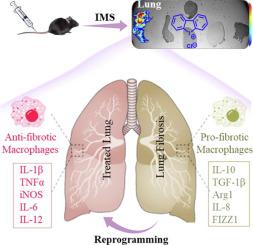Journal of Advanced Research ( IF 11.4 ) Pub Date : 2022-04-29 , DOI: 10.1016/j.jare.2022.04.012 Huirui Wang 1 , Yinghui Gao 1 , Li Wang 2 , Yang Yu 3 , Jiaozhen Zhang 1 , Chunyu Liu 1 , Yaxin Song 1 , Haochuan Xu 4 , Jingcheng Wang 1 , Hongxiang Lou 1 , Ting Dong 1

|
Introduction
Pulmonary fibrosis (PF) is a fatal disease with a variable and unpredictable course. Effective clinical treatment for PF remains a challenge due to low drug accumulation in lungs and imbalanced polarization of pro/anti-fibrotic macrophages.
Objectives
To identify the alteration of immunometabolism in the pulmonary macrophages and investigate the feasibility of specific inhibition of M2 activation of macrophages as an effective anti-PF strategy in vivo.
Methods
The high-content screening system was used to select lung-specific homing compounds that can modulate macrophage polarization. Imaging mass spectrometry (IMS) conjugated with chemical proteomics approach was conducted to explore the cells and proteins targeted by diphenyleneiodonium chloride (DPI). A bleomycin-induced fibrotic mouse model was established to examine the in vivo effect of DPI.
Results
Pulmonary macrophages of PF at late stage exhibited predominantly the M2 phenotype with decreased glycolysis metabolism. DPI was demonstrated to inhibit profibrotic activation of macrophages in the preliminary screening. Notably, IMS conjugated with chemical proteomics approach revealed DPI specifically targeted pulmonary macrophages, leading to the efficient protection from bleomycin-induced pulmonary fibrosis in mice. Mechanistically, DPI upregulated glycolysis and suppressed M2 programming in fibrosis mice, thus resulting in pro-fibrotic cytokine inhibition, hydroxyproline biosynthesis, and collagen deposition, with a concomitant increase in alveolar airspaces.
Conclusions
DPI mediated glycolysis in lung and accordingly suppressed M2 programming, resulting in improved lung fibrosis.
中文翻译:

二亚苯基氯化铵的肺部特异性归巢通过抑制巨噬细胞 M2 代谢程序改善肺纤维化
介绍
肺纤维化(PF)是一种致命疾病,其病程多变且不可预测。由于肺部药物蓄积低以及促/抗纤维化巨噬细胞的极化不平衡,有效的 PF 临床治疗仍然是一个挑战。
目标
鉴定肺巨噬细胞免疫代谢的改变,并研究特异性抑制巨噬细胞M2活化作为体内有效抗肺纤维化策略的可行性。
方法
高内涵筛选系统用于选择可以调节巨噬细胞极化的肺特异性归巢化合物。采用成像质谱(IMS)结合化学蛋白质组学方法来探索二亚苯基碘鎓氯化物(DPI)靶向的细胞和蛋白质。建立博莱霉素诱导的纤维化小鼠模型来检测 DPI 的体内作用。
结果
PF晚期肺巨噬细胞主要表现出M2表型,糖酵解代谢降低。在初步筛选中,DPI 被证明可以抑制巨噬细胞的促纤维化活化。值得注意的是,IMS 与化学蛋白质组学方法结合揭示了 DPI 特异性靶向肺巨噬细胞,从而有效保护小鼠免受博莱霉素诱导的肺纤维化。从机制上讲,DPI 上调纤维化小鼠的糖酵解并抑制 M2 编程,从而导致促纤维化细胞因子抑制、羟脯氨酸生物合成和胶原蛋白沉积,同时肺泡空腔增加。
结论
DPI 介导肺中的糖酵解,从而抑制 M2 编程,从而改善肺纤维化。











































 京公网安备 11010802027423号
京公网安备 11010802027423号